Honduras
Things to Do
Copán Ruinas
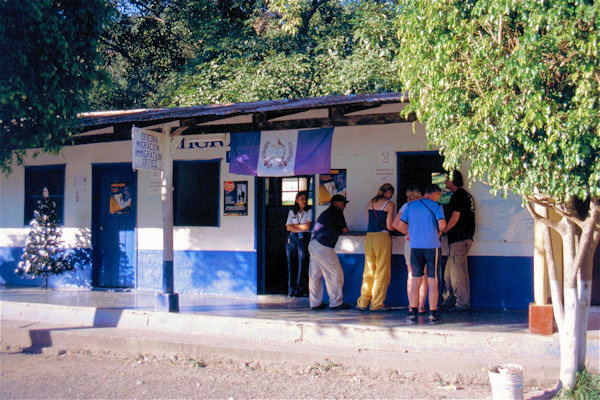 |
|||||
Comming out of Guatemala you will have to cross the border to reach Copan. At the crossing you must present you'r passport to the
Guatemalan immigration and customs authorities, then cross the border and do the same thing with the Honduran authorities.
Money changers will approach you on both sides of the border anxious to change quetzals for Hunduran lempiras, or either for US dollars.
Usualy they're offering a decentrate because there's a Guatamalan bank right there and the current exchange rate is posted in the
Honduran immigration office - look for it.
It's quit relaxing, and when you're lucky you can even buy a ice-cream there.
The town of Copán Ruinas, is a beautiful place paved with cobblestones and lined with white adobe buildings with red-tile roofs.
The town, is a major gateway for tourists traveling to the Pre-Columbian ruins of Copán.
Copán
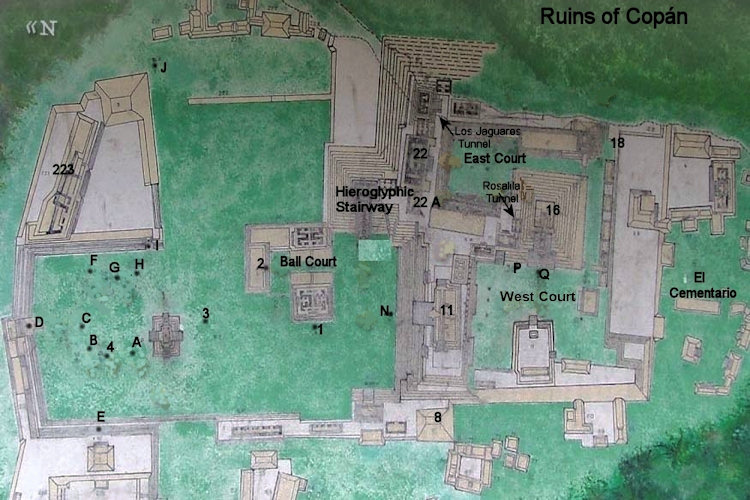
In the 5th century AD one royal family came to rule Copan, led by a mysterious king named K'inich Yax K'uk' Mo' (Great Sun Lord
Quetzal Macaw), who ruled from AD 426 to 435.
Archaeological evidence indicates that he was a great shaman, and later kings revered him as the semidevine founder of the City.
The dynasty ruled throughout Copan's florescence during the Classic period (AD 250 to 900)
The period of greatest architectural construction, considered to be the hight of Copan's dynasty, began 553 with the accession of
Tzi-B'alam (Moon Jaguar), who buildt the Rosalila Temple.
The city's 12th ruler, Chan Imix K'awiil, (known as Smoke Imix) (628-696) was leaving more inscribed monuments and temples
than any other ruler.
His successor Uaxaclajuun Ub'aah K'awiil (18 Rabbit), was also a prolific builder who gave final form to the Great
Plaza and the Ball Court. He also encouraged the development of sculpture, from low-relief to the nearly full-round style
of later years.
It is Ajaw K'ak' Yipyaj Chan K'awiil (Smoke Shell) (749-763) who was one of Capan's greatest builders. He commissioned the
city's most famous and important monument the great Escalinata de los Jeroglificos (Hieroglypic Stairway) with immortalizes the
achievements of the dynasty from its establisment until 755, when the stairway was dedicated. It is the longest inscription ever
discovered in the Mayan lands.
Stelae Court
"In every civilization of the ancient world, there are art works and monuments that stand out among their fellows as objects of
special character. The great portrait sculptures that stand in silent rows down the center of the Great Plaza of Copan created one
of these special places. They constitute one of the great masterpieces of the Maya legacy.
Although the artists who made them did not sign their works and leave us their names, the patron of these great works did. He was
Uaxaclajuun Ub'aah K'awiil (commonly known as 18 Rabbit), the thirteenth king of the Copan dynasty."
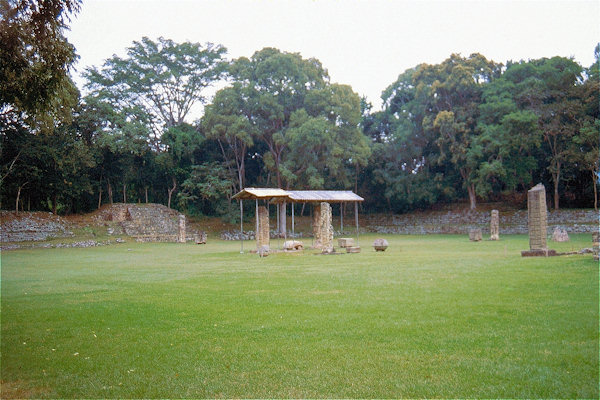 |
|||||
Stelae A
The tall crown of woven matting that 18-Rabbit wears belongs to an ancient iconographic complex that that show the spirit of a
deified ancestor appearing to his descendant. The floating ancestor wears this same woven crown, and his cheek is marked with k'in to
identify him as the sun
Stelae D
Standing at the base of Temple 2, it is the northern stela of the Great Plaza and faces south toward the north stairway of Temple 4. Its
eloquent imagery presents 18-Rabbit in the guise of an old god.
Stelae H
"This magnificent stela depicts Uaxaclajuun Ub'aah K'awiil in the role of the Maize God as he danced at Creation. In the
Classic-period story of Creation, the Maize Gods are the central characters in the drama that explains the processes of death and
rebirth through confrontation with the Lords of Death in Xibalba
Central Plaza
The Ball Court is probably the best-recognized and most often photographed piece of architechture at Copan.
It is the third and final ball court erected on the site and was completed in 738.
No exact information is available on how the game was played, but it is thought players bounced a hard rubber ball off the slanted
walls
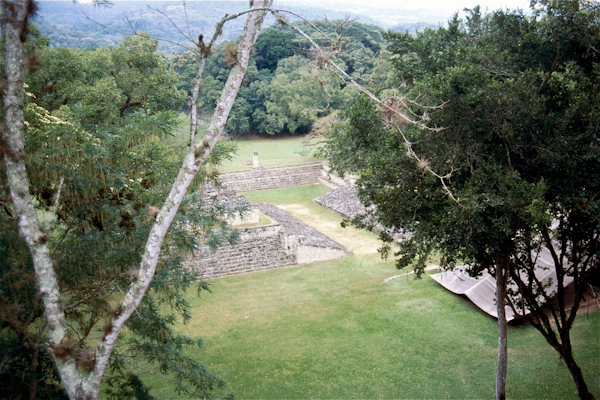 |
|||||
of the court, keeping it in the air without using their hands.
Atop the slanted walls are three intricate macaw heads on each side, as well as small compartments, wich players may have used
as dressing rooms.
Hieroglyphic Staircase
The final version of the Hieroglyphic Stairway was built by Ruler 13 (Uaxaclajuun Ub'aah K'awiil), in re-modelling this ancient
and revered edifice to honor the memory of Ruler 12 (Chan Imix K'awiil), by creating a much more complete record of the city's
dynastic history. In this innovative effort, he cited the birth, accession to power, important rituals and other achievements, parentage
statements, and death of the most distinguished rulers in the city.
Ruler 15 (Ajaw K'ak' Yipyaj Chan K'awiil), whose stela stands at the foot of the stairway] subsequently doubled the length
and historical content of the stairway inscription, and was likely also responsible for creating the balustrades that framed it.
East Court
18-Rabbit's most memorable work during this period was Temple 22, a building that has long been admired as one of the finest of all Maya architectural expressions. This temple's last and most ambitious manifestation was constructed with mud mortar, a kind of construction that required constant and careful maintenance to ensure
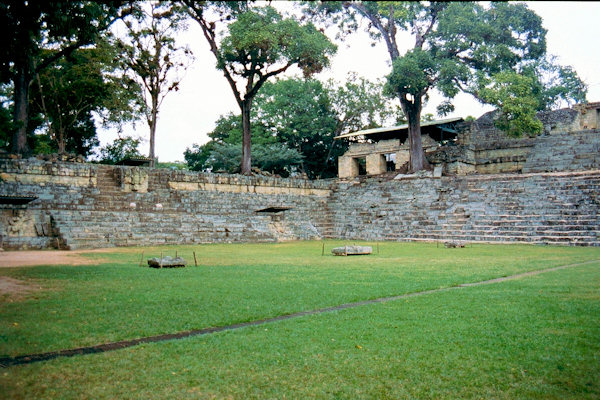 |
|||||
that its plaster seal did not leak and weaken the walls.
Once the Copanecs no longer maintained it, it deteriorated and collapsed. Today we have only fragments of the beautiful sculptures
that once decorated it--pieces found lying in the grass by the temple's feet--but they are enough to help us contemplate the building's
lost beauty and significance
Popol Nah
On the west side of 18 Rabbit's temple at Copan stood the Popul Nah, or "Council House", the working space of this meeting place was
not the close interior of the shrine but a space outside, under the sun and stars.
Jaguar Staircase
A supernatural patron of war and sacrifice, the Jaguar God has been interpreted as an aspect of the jaguar twin of the Popol Vuh
myth and as a personification of the night Sun as it travels through the underworld. The god's attributes include the large eyes
with scroll pupils, the twisted crueller that rests between them, and the upswept topknot of hair that both twins wear in their
guises as Chac and the Baby Jaguar.
West Court
Yax Pasaj Chan Yopaat (known as Yax Pac the 16th and last ruler of Copan) designed the ground floor of this
temple with a wide east-west gallery crossed by a smaller north-south corridor.
In this way he engineered an entrance to the building from each of the four cardinal directions--north, east, south, and west. Just
inside each of these four doors, panels facing one another record historical events important to Yax-Pac's political strategy and
the dedication of the temple itself.
What is curious about each pair of texts is that one is in normal reading order, while the other facing text reads in reverse order
as if you are seeing a mirror image.
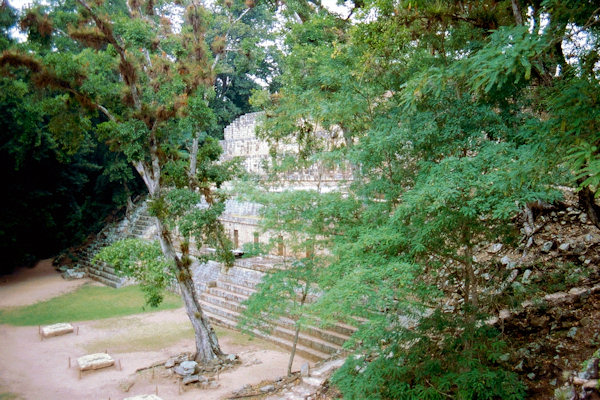 |
|||||
The two Howler Monkey Gods flank the stairway that rise from the West Court are thought to be associated with music and dance,
as well as literature, and the left-hand monkey strikes a theatrical pose with what is said to be a rattle in his hand.
The Heads of Pauahtun
The two Pauahtun heads found at Copán are amongst the most iconic of all the stone carvings and are often referred to as the
Old Man of Copan. Age is thought to be indicative of wisdom and it is thought Pauahtun may be an elderly incarnation of the
great God Itzamna who created the universe at the beginning of the Mayan era.
Altar Q
Altar Q, buildt by Yax Pac, a square bench illustrating all 15 rulers of the dynasty around its side, with the first
K'inich Yax K'uk' Mo' passing the baton off leadership to Yax Pac.
Although he may not have known it when he commissioned it, Yax Pac left on the small stone a brief resume of the city's entire history.
El Cementerio
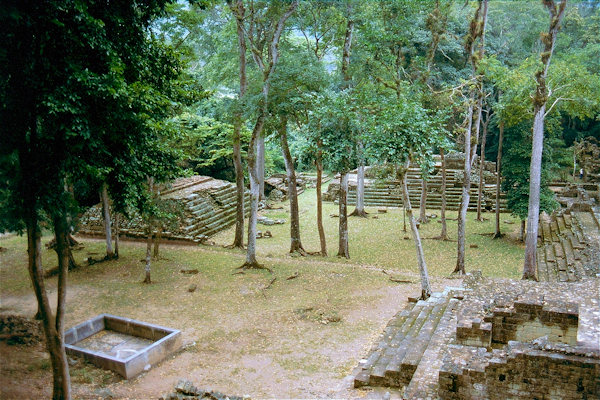 |
|||||
This group is a Residential Area located south of the Great Plaza, believed to have been the living quarters of the
ruling elite and their closest relatives.
It is The Cemetery Complex because of the large amount of skeletons found beneath each of the dwellings.
After studying the bone remains found in this group it was determined that the ruling class at Copan was a polygamic society, where
one person was married to more than one spouse. A large amount of female bone remains found in some of the dwellings seems to
hint at this when compared with the amount of male bone remains.
La Sepulturas
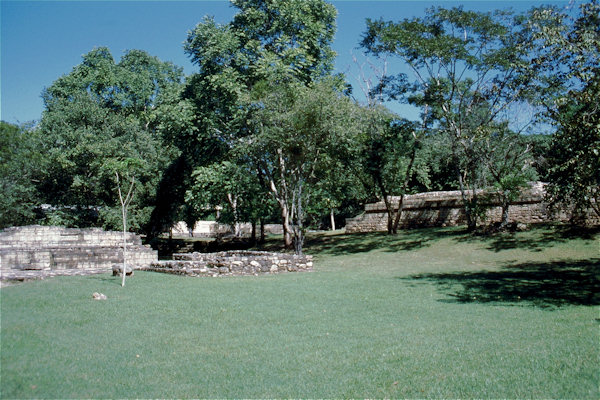 |
|||||
Las Sepulturas was a residential area for the nobility of Copan, and is situated a little more than a kilometre north-east
of the main city. It was connected directly to the main ceremonial centre by a large sacred road known as a sac’be.
Although it is a relativity small site, it is home to a lot of archaeological investigation and some very important finds have been
uncovered here which have helped historians piece together the history and prehistory of Copan.
House of the Bacab holds on the outside, the remnants of two busts set within false windows either side of the door.
These busts are of Pauahtun figures holding scribal instruments, which consisted of a half shell paint holder and a stylus.
Lago de Yojoa
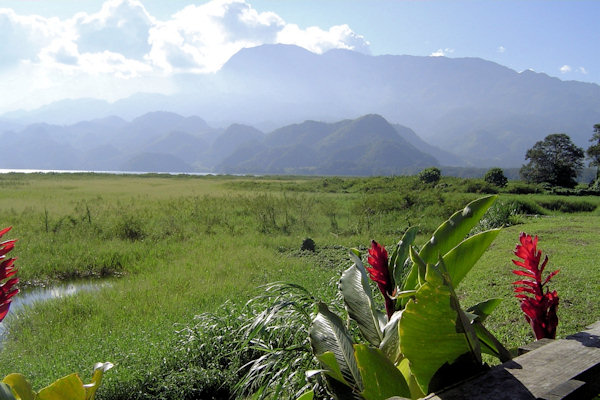 |
|||||
Honduras's largets natural lake, Lago de Yojoa, is roughly 16 kilometers long by eight kilometers wide, at an altitude of
635 meters: lake depth varies between anout 18 and 25 meters, depending on season.
The setting, backed by the majestic cloud-forested mountains of Santa Barbera and Cero Azul/Meambar (both protected
as national parks) is spectacular.
Pulhapanzak Falls
Just north of the Lago de Yojoa is the 43-meter-high Pulhapanzak Falls.
To properly admire the falls , follow the steps down along the edge of the river to a vieuw-point below. Take care to stay on the steps,
as the short-cut pathway is slippery and steep.
Tegucigalpa
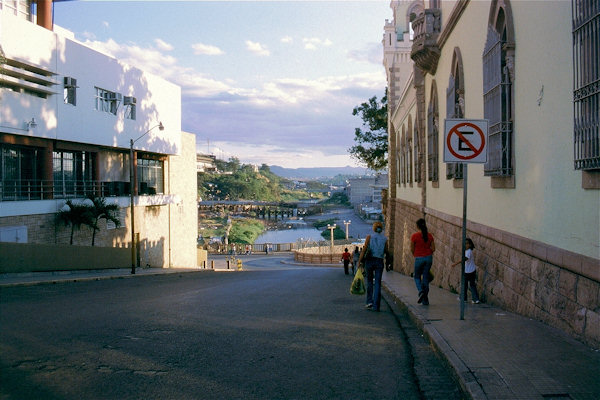 |
|||||
Honduras's capital, a city of just over one million inhabitants, occupies a high mountain valley around 1.000 meters above sea
level, with the Rio Choluteca running right down the middle.
Visitors have no problem finding places and sites to see, including several colonial churches, three museums, a large market area,
and plenty of handicraft stores, all in the downtown area.
Dominating a large square filled with vendors, Iglesia los Delores is a large, bright white church with a relatively plain
facade but featuring several attractive pieces of religious art inside, including relief paintings of the stations of the cross, a
gilded, carved altarpiece and the painted interior dome. The church was buildt in 1732.
Parque Central
Tegucigalpa's downtown squere is a great place to relax and people-watch. It's invariably full of city folk walking around,
buying newspapers, selling odds and ends, or just hanging out.